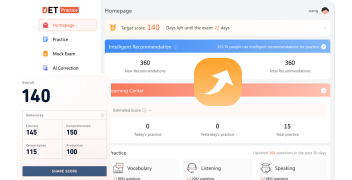デュオリンゴ英語テスト インタラクティブリスニング – 完全ガイド(新バージョン)
みなさんこんにちは。DET Practice、Duolingo English Test上級コースへようこそ。本日は、出題形式であるInteractive Listening Course(インタラクティブ・リスニング講座)について学びます。インタラクティブ・リスニング問題は2025年7月にアップデートが行われたため、まずはこの問題タイプの紹介を見ていきましょう。
インタラクティブ・リスニング問題は、各DET試験で2回出題されます。この設問形式は、以下の3つのパートから構成される総合型問題です:
- Listen and Complete: 毎回3~4問出題され、推奨解答時間は2分30秒です。
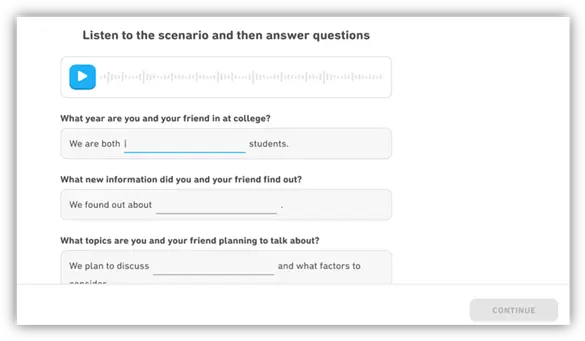
- Listen and Respond: 毎回5~6問出題され、推奨解答時間は4分です。
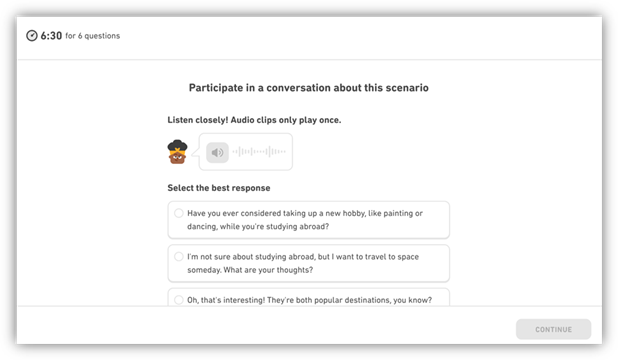
- Summarize the Conversation: 解答時間は1分15秒です。
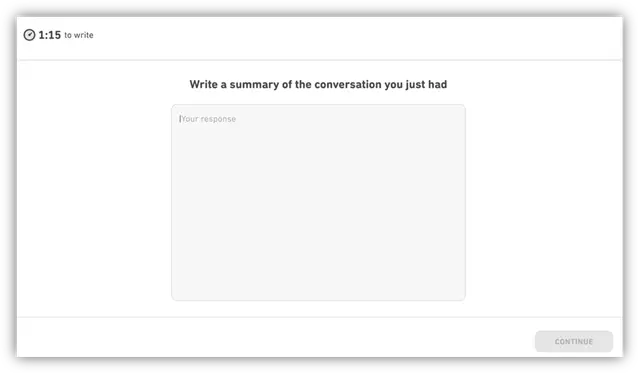
リスニング素材のシナリオは主にキャンパスライフやアカデミックなトピックに焦点が当てられており、TOEFLリスニングの会話シーンに似ています。評価される能力は非常に総合的で、リスニング内容の理解や場面語彙の習得だけでなく、受験者のライティング力も問われます。
パート1:Listen and Complete
このセクションでは、まずリスニングシナリオの音声イントロダクションを聞きます。以前と異なり、この部分はテキスト表示されません。受験者はこのシナリオ紹介音声を聞き、その後の3~4つの文補完(空所補充)問題を解答します。
推奨解答時間を2分30秒としている理由は、このパートが第2パート(Listen and Respond)と合わせて6分30秒を共有しているためです。他のリスニングセクションと違い、このパートの音声は何度でも再生でき、再生中に一時停止して解答することもできます。また、解答順に指定はなく、確実な文から先に埋め、難しい箇所は後回しにすることも可能です。
このパートでは埋める単語数が明記されていませんが、多くの設問は2~3語を求められ、最大でも10語以内です。したがって、解答時には必要なキーワードのみ入力すれば十分です。ただし、完成した文として意味が通じるようにし、文法上や語順のミスがないようにも注意しましょう。
採点基準
この問題タイプは客観式ですが、正答との一致度による自動採点です。単純な正誤判定ではなく、単語抜けや余計な単語、スペルミスなども部分点が入りますが、その分減点となります。
Listen and Complete攻略ポイント
- シナリオ紹介は音声セグメントで、試験時間内なら繰り返し再生や一時停止が可能です。
- シナリオ紹介の初回再生中は設問が見られないので、全神経を傾けて聞き取り理解に集中しましょう。
- 空所の下線の長さは語数とは無関係です。スペースが足りなければ自動で下線が延びます。
- ほとんどの空所補充は2~3語、最大でも10語以内です。
パート2:Listen and Respond
このセクションは毎回5~6問のサブ設問があります。Listen and Respondセクションでは、受験者は会話の当事者になりきり、会話文を複数選択肢問題で完成させます。推奨解答時間は4分で、パート1と同じく6分30秒の制限時間を共有しています。
パート1と異なり、このセクションの音声は一度しか再生できません。音の識別力を向上させるために、事前にインタラクティブリスニングの頻出シナリオ語彙を覚えておくと効果的です。
また、パート2の紹介の前に、パート1のシナリオイントロダクションを振り返りましょう。パート2では、シナリオ紹介音声とパート1の空所補充解答を再生/参照できます。これらの情報も、Listen and Respondの選択肢判断やパート3のSummary問題の参考になるため、意識して活用しましょう。
Listen and Respond攻略ヒント
選択肢を選ぶ際は、会話の参加者同士の関係性(学生同士か、教師と学生かなど)に注目しましょう。これにより、会話にふさわしい内容を選択しやすくなります。
間違った選択肢を選んだ場合でも、正答が画面に表示されます。これにより、リスニング内容の理解度を高めたり、前の聞き取り内容の復習ができます。
選択肢解答後は会話の要点を意識的に記憶し、続くパート3のSummarize the Conversationに備えましょう。パート3ではパート1・2の内容は参照できません。
パート3:Summarize the Conversation
インタラクティブリスニング最後のセクションは記述式問題です。直前の会話内容を要約する英作文をしなければなりませんが、制限時間は75秒のみとなっています。
この限られた時間内で、ひとまとまりの段落を書き切る必要があるため、核心から文章を書き出してメイントピックを中心にまとめましょう。細かいディテールより主題が大切です。また、原則として一人称(自分の視点)、過去形を基本とし、必要に応じて他時制も混ぜましょう。
インタラクティブリスニングで頻出のシナリオ例
インタラクティブリスニングでは、受験者が「学生」役になることが多いです。もう一方の会話相手は、教師や職員など学校関係者の場合もあります。この場合、会話内容例は次の通りです:
- 課題や論文についての相談
- 授業内容に関する質問
- 研究プロジェクトに関する指導
また、相手も学生や友人(同じ立場)という設定なら、例えば:
- 学習アドバイス
- 趣味や関心事について
これら典型的なシナリオを知っておくと、関連する語彙を蓄積でき、リスニング理解がしやすくなります。
サンプル・インタラクティブ・リスニング問題の流れ
サンプル問題で、インタラクティブリスニングの解答法を見ていきましょう。まずはシナリオ紹介部分。最初の再生時は空所補充問題が見られない点に注意してください。
試験でこの画面になると、自分で再生ボタンをクリックして音声を流すか、数秒待つと自動再生されます。
一度音声を聞いた後、補うべき空欄問題が表示されます。ここでは4つの文を完成させる必要があります。まずは素早く設問全体に目を通しましょう。
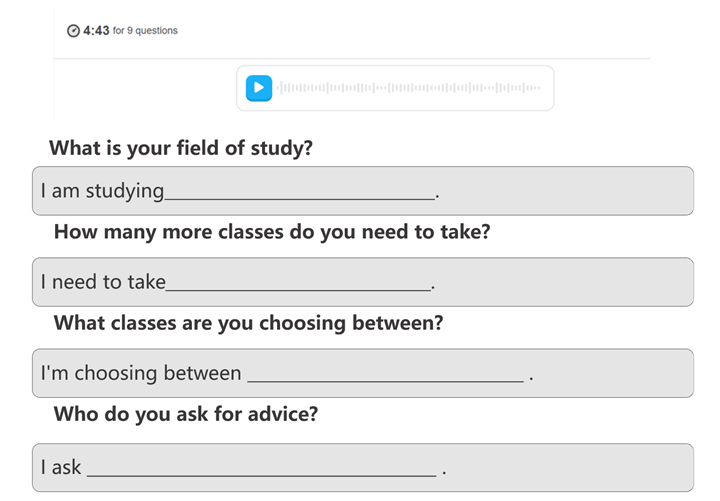
設問を読むと、ほとんどがシナリオ紹介で述べられた具体的な情報を問うものであると気づきます。
シナリオ紹介内容:
*"あなたは会計(accounting)を学んでいる学生です。学位取得のためにあと2科目履修する必要があります。履修候補はMarketingかBusiness Communicationのいずれかで、教授にアドバイスを求めます。"*
ハイライトされた部分が空欄補充に必要なキーワードです。
解答例:
- 専攻分野は何ですか? → accounting
- あと何科目履修する必要がありますか? → two more classes
- どの科目で迷っていますか? → Marketing and Business Communication
科目名は英語表記では頭文字を大文字にすること(タイトルケース)が多いので、それにならいます。また、オリジナルの語句をできるだけそのまま書くのが原則ですが、必要があれば文法上の微調整は可能です。
パート2の解説
設問1:
教授:"Hi, there! What can I do for you?"
この短い音声では具体的な情報がありません。自分の目的をはっきり伝えるだけです。パート1のシナリオ紹介を根拠に解答を選びます。
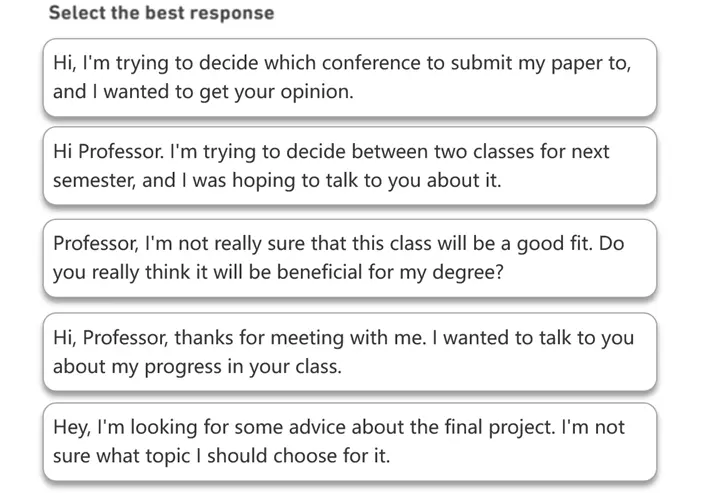
パート1から、学生は2つの科目で迷っていることが分かっています。選択肢2:「Hi Professor. I'm trying to decide between two classes for next semester, and I was hoping to talk to you about it.」が場面に合致する正答です。
設問2:
教授:"Sure! I'm happy to help. What are the two classes?"

教授がどちらの科目で悩んでいるか尋ねました。シナリオ紹介の内容から、選択肢4の「Marketing and Business Communication」が正答です。
設問3:
教授:"They're both good classes. They cover different topics, though..."
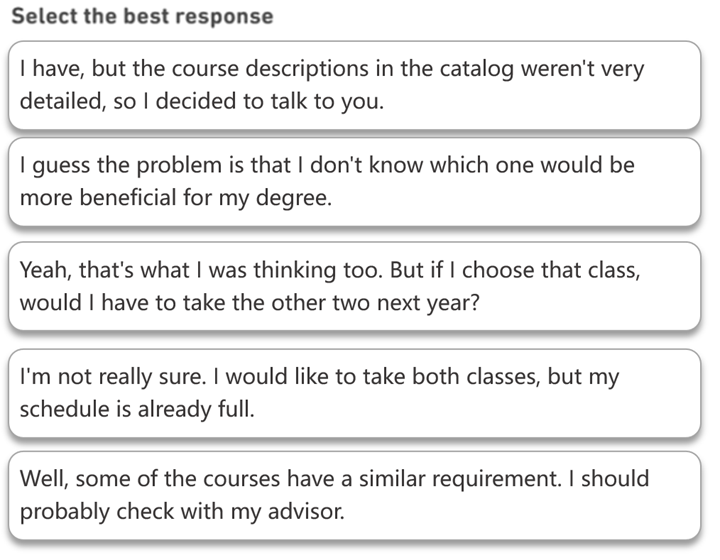
教授はそれぞれの科目の特徴を説明しています。ここはシナリオ紹介から直接の答えが取れず、内容に合った選択肢2を選びます。
設問4:
教授:"That really depends on what you want to do after you graduate..."

進路アドバイスを受けた場面なので、選択肢2「That makes sense...」が妥当な反応です。
設問5:
教授:"Yeah, that's probably a good idea..."
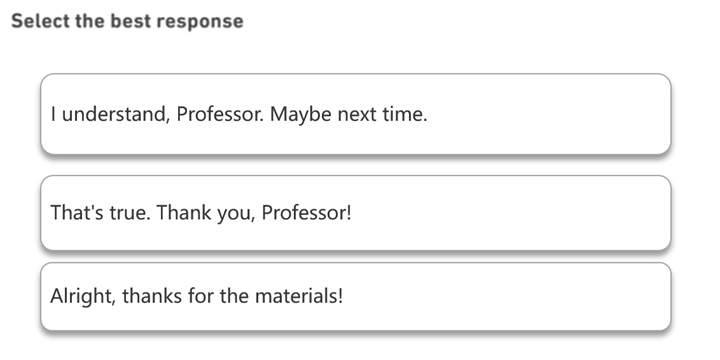
教授の助言への感謝の意を述べるタイミングなので、選択肢2(Thank you for your help, Professor.)が適切な選択です。
パート2の戦略ポイント
初期の設問ではパート1シナリオ紹介を根拠に選択肢を絞り、後半の難しい設問では選択肢を丁寧に比較・分析する力が必要です。
誤答選択肢の特徴:
- 指示語の指すものが不明瞭
- 会話内容と矛盾、または食い違いがある
- 本文で全く言及されていない内容
常に設問・選択肢をよく比較し、典型的な誤答パターンに慣れておくと正答率が高まります。
パート3:Summarize the Conversationの構成と戦略
制限時間75秒と非常に短いため、冒頭から要点を書くべきです。不完全なまま終わらないよう、メインテーマを簡潔にまとめましょう。
おすすめ構成:
- 登場人物の立場・背景(学部・専攻など)
- 直面した問題
- 誰に相談したか
- アドバイス・提案や解決策
- 結論(時間が余れば)
時間が足りなければ、解決策までで止めても構いません。
ライティングテンプレート例
問題・解決型テンプレート:
- 冒頭:"The conversation is about [会話のテーマ]"
- 立場・問題:"I am a student who has a problem about [具体的な悩み]"
- 相談:"I talk to [相手] who is [関係] and ask for their help"
- 解決策:"They suggested that I should [アドバイス/解決策]"
- 結論(余裕があれば):"As a result, ..." など
学業Q&A型テンプレート:
- 立場・疑問:"I am a student who was confused about [知識/概念]"
- 説明:"They answered my question and clarified [知識/概念] with [例/定義/説明]"
- 結論:"The conversation helped me to learn more about [テーマ]"
テンプレート利用上の注意:
- 必ず会話テーマに合致する内容にする
- 全ての設問で同じテンプレートは使わない
- 文法・スペルミスに注意し、型通りだけでなく独自練習も重ねる
- 時間が厳しい場合、冒頭や結論文は省略可
サンプルサマリー
*"The conversation is about getting advice on course selection. I am a student who has a problem choosing between a marketing class and a business communication class for the next semester. I talk to my professor and ask for his advice. He suggested that I take business communication because I'm not sure about my future career. I think his idea is very practical, and I decided to follow it."*
インタラクティブ・リスニングガイドまとめ
インタラクティブリスニング全体構成
- Listen and Complete: 会話シナリオ背景音声を聞き(繰り返し再生・一時停止可)、3~4つの穴埋め文を完成させる。
- Listen and Respond: 音声は1回のみ再生。会話の一部を聞いて選択肢で会話を完成させる。
- Summarize the Conversation: パート2の会話内容を英語で75秒以内に要約するライティング問題。
繰り返し再生機能の活用:特にパート1(Listen and Complete)は、音声の何度でも再生・一時停止機能を最大限活用し、2~3語程度のキー情報を丁寧に聞き取る癖をつけましょう。文として自然につながるか、文法エラーがないか、解答後に必ず確認しましょう。
場面・シナリオ理解重視:パート2の会話はキャンパス生活やアカデミックな設定が多いです。登場人物同士の関係性(学生―教授、友人同士など)を把握すると、正しい選択肢を絞り込みやすくなります。
高い集中力の維持:パート2は音声が一度しか流れないため、とにかく集中が不可欠です。選択肢解答直後には正答も表示されるので、次回以降の類似設問対策や理解強化に生かせます。
要点の記憶:パート2の主要内容(主題や解決策等)を意識して記憶し、続くサマリー記述に備えましょう。
定型構成で英文作成:「主要人物+具体的な問題+誰に相談したか+受けたアドバイス」の型をベースに要約文を組み立てましょう。
テンプレート活用・練習:「問題/解決型」や「学業Q&A型」のモデル文を参考にしつつ、型どおりになるだけでなく、必ず演習を積みながら自分でまとめられる力を養いましょう。
その他リソース
さらに詳しく:
インタラクティブリスニングの後半2パート(Listen and Respond・Summarize the Conversation)の詳細は、Duolingo English Test 問題タイプ一覧 - Interactive Listening編を参照してください。
この問題タイプ対策(特にタイピングスピード・75秒サマリー攻略など)の戦略についてはInteractive Listening Made Easy(インタラクティブリスニング完全対策)も参照できます。


